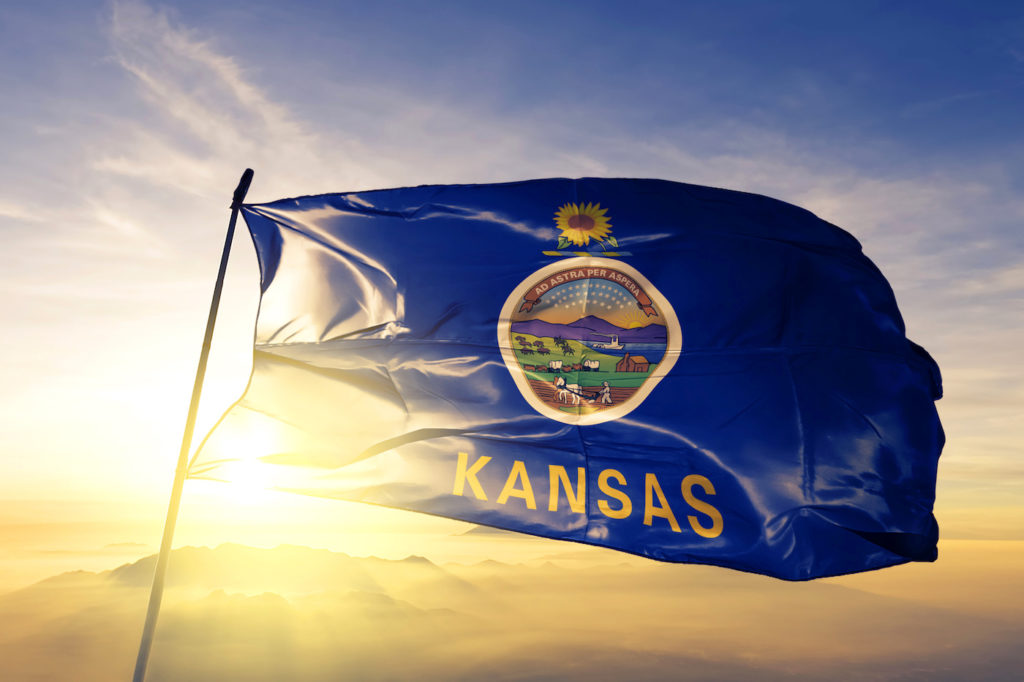The thirty-fourth state is the product of a literal culture war. Raids, battles, and skirmishes about slavery’s morality and legality had earned the territory the moniker “Bleeding Kansas.” Throughout the latter half of the 1850s, it was unclear whether Kansas would ban slavery or permit its corrupting spread.
Two causes are often cited for Kansas’s early pains. Both are now recognized as moral and legal failures. The first was the Kansas-Nebraska Act, a law that replaced Congress’s earlier limitations on slavery’s spread with a permissive attitude toward a state’s “freedom to choose” slavery or its opposite. The second was the Dred Scott decision, the most infamous of all Supreme Court decisions, which forced the American people to answer—ultimately through a civil war and constitutional amendments—the chief moral question of the time.
After the failure of Congress and the Supreme Court, Kansans took it upon themselves to ensure their state constitution was clear on the issue of human rights. In 1861, champions of human liberty were rewarded with the ratification of the Wyandotte Constitution. Its bill of rights boldly stated that “[t]here shall be no slavery in this state.”
Kansas faces a parallel challenge at the current moment. Following the Kansas Supreme Court’s 2019 decision in Nauser v. Schmidt, as well as the expected reversal of the US Supreme Court’s Roe v. Wade decision, Kansas citizens are now asked to shape their constitution in light of the day’s most pressing moral questions. Just as they were asked over 160 years ago, Kansans must decide whether their constitution subjugates one class of human beings to the will of another, or instead all human lives should be treated with dignity and respect.
Start your day with Public Discourse
Sign up and get our daily essays sent straight to your inbox.The Blindness of Nauser v. Schmidt
As Justice Alito pointed out in the leaked Dobbs v. Jackson Women’s Health draft opinion, the reasoning behind Roe v. Wade was “exceedingly weak,” and this weakness was largely recognized by experts and legal scholars. Yet this weakness in reasoning did not prevent the Kansas Supreme Court from Roe-like judicial legislating in the 2019 decision Nauser v. Schmidt.
In Nauser, the Kansas Supreme Court made the baffling assertion that the rights enshrined in Kansas’s Wyandotte Constitution include the right to abortion. While recognizing that the right to abortion is “not absolute,” the court held it is nonetheless “fundamental” and cannot be restricted unless the government has a compelling interest to do so. The logic of the decision means that the state does not have a compelling interest in protecting the unborn.
The court reached this conclusion through twisted natural-rights reasoning. While the court’s Nauser decision has been previously criticized at Public Discourse (here and here), my purpose in this essay is to illustrate how the court perverted the Kansas Constitution for which hundreds of Kansans gave their lives, and which caused generations of Kansans to recognize themselves as children of a free state.
Kansans must decide whether their constitution subjugates one class of human beings to the will of another, or whether instead all human lives should be treated with dignity and respect.
The Wyandotte Constitution, according to the Nauser court, recognized natural rights; specifically, the right to life, liberty, and the pursuit of happiness. The Wyandotte Constitution rejected the bill of rights in Kansas’s failed pro-slavery constitution, which only guaranteed such rights to a certain class of (politically important) people, i.e., free persons. The court buttressed its interpretation of the Wyandotte Constitution by appealing to Abraham Lincoln, who recognized that—while persons are obviously not equal in “color, size, intellect, moral developments, or social capacity”—they are nonetheless equal in inalienable rights.
Among these inalienable natural rights, the Nauser Court explained, was liberty and autonomy. And while the delegates at the Wyandotte Constitutional Convention may have failed to recognize it, these rights extend to both men and women. The framers of the Kansas Constitution, the Court mused, may have been blind to the rights of women, but we are not so blind anymore.
Despite its enlightened air, the Nauser court remained morally blind. It saw that the Wyandotte Constitution extended natural rights like life, liberty, and the pursuit of happiness to blacks and to women; but it never once considered whether those rights extend to the unborn.
The Nauser court praised the natural right to liberty and autonomy, even though the Wyandotte Constitution logically required recognizing the limitations of liberty and autonomy, as liberty and autonomy cannot justify exercising one’s will over a slave. The court never once asked whether we may permissibly exercise liberty and autonomy at the expense of another human’s natural rights. This is a puzzling fact, given that the hallmark of the Wyandotte Constitution was its ban on slavery: it solidified the commonsense point that one’s liberty and autonomy cannot infringe on another human’s natural rights, even if that other human’s social standing or political rights are inferior or unrecognized.
In short, the Nauser court twisted the Kansas Constitution beyond recognition. The Kansas Supreme Court, while acknowledging previous generations’ moral blindness to the natural rights of all, remained blind even to the question of the natural rights of the unborn. It held that the very constitution that banned slavery simultaneously mandated that certain human beings have the liberty and autonomy to choose whether another human being lives or dies—a liberty and autonomy arguably greater than that exercised by slaveholders.
This is not the constitution “Bleeding Kansas” was fought for. But Kansans now have the opportunity to take it back.
The “Value them Both” Amendment
In an effort to take the back the Kansas Constitution, lawmakers have proposed an amendment to it. The Value Them Both Amendment is not explicitly pro-life, but it is decidedly anti-Nauser. The text is straightforward:
Because Kansans value both women and children, the constitution of the state of Kansas does not require government funding of abortion and does not create or secure a right to abortion. To the extent permitted by the constitution of the United States, the people, through their elected state representatives and state senators, may pass laws regarding abortion, including, but not limited to, laws that account for circumstances of pregnancy from rape or incest, or circumstances of necessity to save the life of the mother.
In other words, the effect is to undo the Kansas Supreme Court’s error. Even those on the pro-choice side of the aisle, upon reviewing the Court’s Nauser decision, will recognize that the court utterly failed to take into account the moral status of the unborn child. And even an abortion-rights advocate should realize that the moral weight of a living (though embryonic) human being is a serious moral question. Yet it is a question the Nauser court completely ignored. This failure prevents Kansans—no matter what their side of the political aisle—from pursuing public policy seriously grappling with the moral arguments surrounding the rights of women and the unborn.
The Kansas Supreme Court ignored the question about the moral status of the unborn, which is the ultimate question on which the entire debate hinges.
The Nauser court ignored the question about the moral status of the unborn, which, as Michael Stokes Paulsen recently pointed out at Public Discourse, is the ultimate question on which the entire debate hinges. By ignoring this question and calling the right to abortion “fundamental,” the Nauser court implicitly provided an answer: under the Wyandotte Constitution, Kansans cannot debate the moral status of the unborn in the political arena.
The “Value them Both” Amendment brings this question—the most hotly contested moral issue of our time—back into the political arena. Just as our nation required constitutional amendments to rectify perversions of its Constitution by the courts, so too does Kansas require the “Value them Both” amendment.
“Valuing them Both” in a Post-Roe Kansas
The amendment can be ratified by popular vote on August 2, 2022. Kansas lawmakers have already done their part by putting the amendment on the ballot; it is the duty of Kansans to take back their constitution.
This vote will probably come in the wake of a Supreme Court decision overturning—or at least curbing the effects of—Roe v. Wade. If so, the question of abortion will be in the hands of the states. If the amendment passes, Kansans will retain the ability to regulate abortion within their state. If the amendment fails, Kansas may—despite its perception as a conservative state—become an abortion destination, and its citizens may be without recourse. Kansas already has an ugly history on that front, as for many years Wichita doctor George Tiller was one of the only doctors in the country who performed late-term abortions.
With the fall of Roe, it will become that much more important for citizens to take an active role in abortion legislation. But we must proceed with caution. As the name of the Kansas amendment recognizes, we must seek to address the problem of abortion while upholding the dignity of the mother as well as the child. Abortion-rights advocates love to trash pro-lifers as being anti-women. If the power to regulate abortion in a post-Roe world will return to the people, then the people have a greater moral responsibility to ensure that both children (pre- and post-birth) and their mothers are valued. For Kansans, that means we must live up to the name of the amendment we seek.














